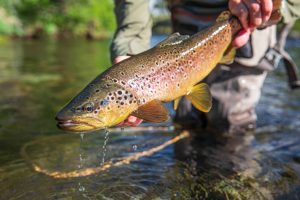Choosing the right fly line is essential for successful trout fishing. Here’s a detailed guide to help you make the best selection:
Floating Lines
- Versatile Choice: Ideal for most trout fishing scenarios, floating lines work well with dry flies, nymphs, and light streamers.
- Surface Presentation: Allows for delicate presentations and easy line control, making it perfect for fishing on the water’s surface.
Sinking Lines
- Deep Water Tactics: Sinking lines are essential when targeting trout in deep lakes or fast-moving rivers where reaching depth is necessary.
- Types of Sink Rates: Choose lines with different sink rates to match the fishing conditions and depth you need to reach.
Weight Forward Lines
- Distance and Accuracy: These lines are designed to provide greater casting distance and improved accuracy, ideal for beginners and experienced anglers alike.
- Easy to Cast: The front-loaded design helps with loading the rod and making long casts.

Double Taper Lines
- Delicate Presentations: Excellent for short to medium casts, offering more subtle presentations for wary trout in clear streams.
- Reversible: The line’s symmetrical design allows it to be reversed for extended use.
Specialty Lines
- Nymphing Lines: Designed with features like a longer belly for better mending and control, perfect for nymph fishing.
- Streamer Lines: Heavier front sections help in casting large streamers and battling strong currents.
Tips for Choosing Lines
- Match the Hatch: Consider the prevalent insect life and water conditions to select lines that suit the environment and target species.
- Test and Adjust: Experiment with different lines to find the best fit for your rod and fishing style.
Selecting the right fly line enhances your trout fishing experience by improving presentation and increasing catch rates. Whether fishing streams, rivers, or lakes, the right line choice is key to success.
Image: HatchMag





